Erringibba is a national park at Glenmorgan in the far west of the Darling Downs region of southern Queensland, Australia, 329 km west of Brisbane. The park was established in 1999 and covers 8.77 km2 (3.39 sq mi). The park lies within the catchment area of the Condamine River and the Brigalow Belt South bioregion.

The blue jay is a passerine bird in the family Corvidae, native to eastern North America. It lives in most of the eastern and central United States; some eastern populations may be migratory. Resident populations are also in Newfoundland, Canada; breeding populations are found across southern Canada. It breeds in both deciduous and coniferous forests, and is common in residential areas. Its coloration is predominantly blue, with a white chest and underparts, and a blue crest; it has a black, U-shaped collar around its neck and a black border behind the crest. Males and females are similar in size and plumage, which does not vary throughout the year. Four subspecies have been recognized.

The crested lark is a species of lark widespread across Eurasia and northern Africa. It is a non-migratory bird, but can occasionally be found as a vagrant in Great Britain.

The crested shelduck, or Korean crested shelduck, is a species of bird in the family Anatidae. It is critically endangered. The male crested shelduck has a greenish-black crown, breast, primaries, and tail, while the rest of its face, chin, and throat are brownish black. The male's belly, undertail coverts, and flanks are a dark grey with black striations. The upper wing coverts are white, while its speculum is an iridescent green. The female has a white eye ring, black crest, white face, chin, throat, neck, and uppers wing coverts and a dark brown body with white striations. Additionally, both sexes have a distinctive green tuft of feathers protruding from the head.

The hooded seal or bladdernose seal is a large phocid found only in the central and western North Atlantic, ranging from Svalbard in the east to the Gulf of St. Lawrence in the west. The seals are typically silver-grey or white in color, with black spots that vary in size covering most of the body. Hooded seal pups are known as "blue-backs" because their coats are blue-grey on the back with whitish bellies. This coat is shed after 14 months of age when the pups molt. It is the only species in the genus Cystophora.

The crested porcupine, also known as the African crested porcupine, is a species of rodent in the family Hystricidae native to Italy, North Africa and sub-Saharan Africa.
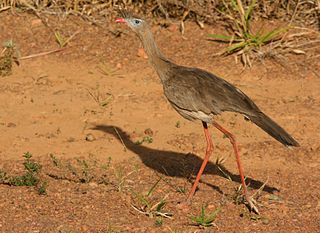
The red-legged seriema, also known as the crested cariama and crested seriema, is a mostly predatory terrestrial bird in the seriema family (Cariamidae), included in the Gruiformes in the old polyphyletic circumscription but recently placed in a distinct order: Cariamiformes.

Azolla cristata , the Carolina mosquitofern, Carolina azolla or water velvet, is a species of Azolla native to the Americas, in eastern North America from southern Ontario southward, and from the east coast west to Wisconsin and Texas, and in the Caribbean, and in Central and South America from southeastern Mexico (Chiapas) south to northern Argentina and Uruguay.
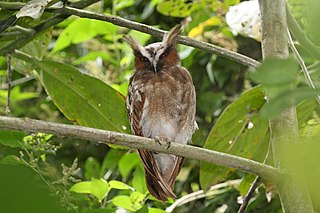
The crested owl is a species of owl in the family Strigidae. It is the only species (monotypic) in the genus Lophostrix. It is a resident bird and occurs in Central America and northern South America. It is a medium-sized owl, easily recognizable with its very long whitish ear tufts and otherwise darker appearance. It inhabits lowland rainforests and prefers old growth in proximity with water. The crested owl is a strictly nocturnal species, but very little is known about its behaviour.
The crested agouti is a species of rodent in the family Dasyproctidae. It is endemic to Guyana and Suriname. Its taxonomic status is uncertain and it may be synonymous with Dasyprocta leporina, leading the IUCN to rate it as Data Deficient.

Anoda cristata is a species of flowering plant in the mallow family known by many common names, including spurred anoda, crested anoda, and violettas. It is native to North and South America. It is known throughout the rest of the Americas as well as Australia as an introduced species and often a noxious weed. It has been found as a weed in Belgium. Naturally, it is often found near streams, in moist meadows, and in disturbed areas.
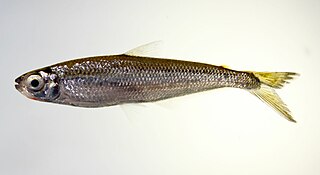
Iguanodectes is a genus of freshwater fish found in tropical South America, with eight currently described species. They are all small tetras, none longer than 5 inches, and often have attractive silvery or striped scales, which makes them a target for the ornamental fish industry. Alongside the genus Piabucus, it is in the subfamily Iguanodectinae, which in turn is in the family Iguanodectidae. The genus Bryconops, which is also in Iguanodectidae, makes up a sister clade to Iguanodectinae.

Casuarina cristata, commonly known as belah or muurrgu, is a species of flowering plant in the family Casuarinaceae and is endemic to inland eastern Australia. It is a tree with fissured or scaly bark, sometimes drooping branchlets, the leaves reduced to scales in whorls of 8 to 12, the fruit 13–18 mm (0.5–0.7 in) long containing winged seeds (samaras) 6.0–10.5 mm (0.2–0.4 in) long.

Lepiota cristata, commonly known as the stinking dapperling, brown-eyed parasol, or the stinking parasol, is an agaric and possibly poisonous mushroom in the family Agaricaceae. A common and widespread species—one of the most widespread fungi in the genus Lepiota—it has been reported from Europe, northern Asia, North America, and New Zealand. It fruits on the ground in disturbed areas, such as lawns, path and road edges, parks, and gardens. The species produces fruit bodies characterized by the flat, reddish-brown concentric scales on the caps, and an unpleasant odour resembling burnt rubber. Similar Lepiota species can sometimes be distinguished from L. cristata by differences in cap colour, stipe structure, or odour, although some species can only be reliably distinguished through the use of microscopy.
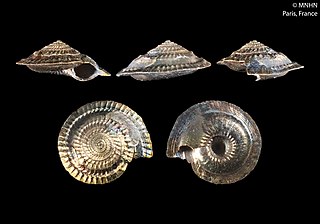
Fluxinella euphanes is a species of extremely small deep water sea snail, a marine gastropod mollusk in the family Seguenziidae.
Sarma Cave, located in the Gagra District of Abkhazia, a breakaway region of Georgia, is the third-deepest recorded cave in the world. Its depth was measured in 2012 by a team led by Pavel Rudko.
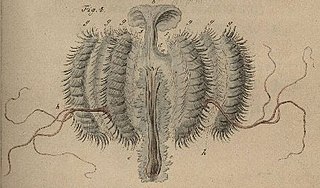
Callianira hexagona is a species of ctenophore of the family Mertensiidae. The scientific name of this species was first published in 1789 by Bruguière.
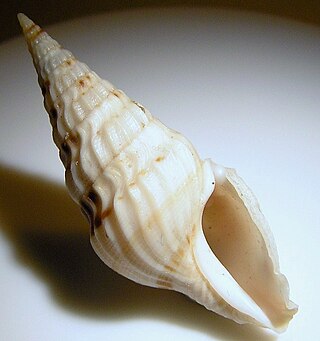
The anal sulcus, also called the anal sinus or anal canal, in Gastropods is a notch, a shelly tube at the top of the aperture. It is the first notch close to the suture. It houses the anal siphon through which the snail expels water and waste products.

Callianira is a genus of ctenophores belonging to the family Mertensiidae.

Callianira bialata is a species of comb jelly within the family Mertensiidae. Comb jellies are gelatinous marine invertebrates characterized by rows of ciliary plates, known as comb rows, which they use for locomotion. Specific morphological details about C. bialata are limited in the provided sources.
















